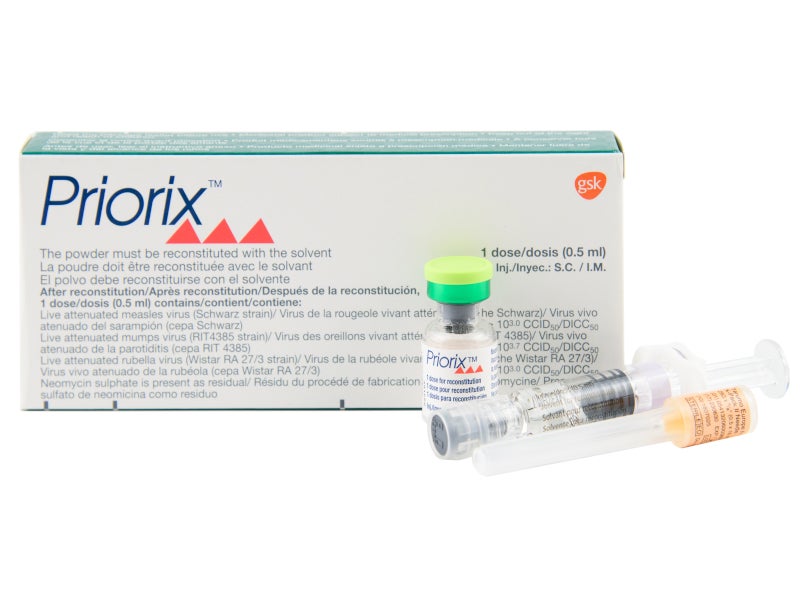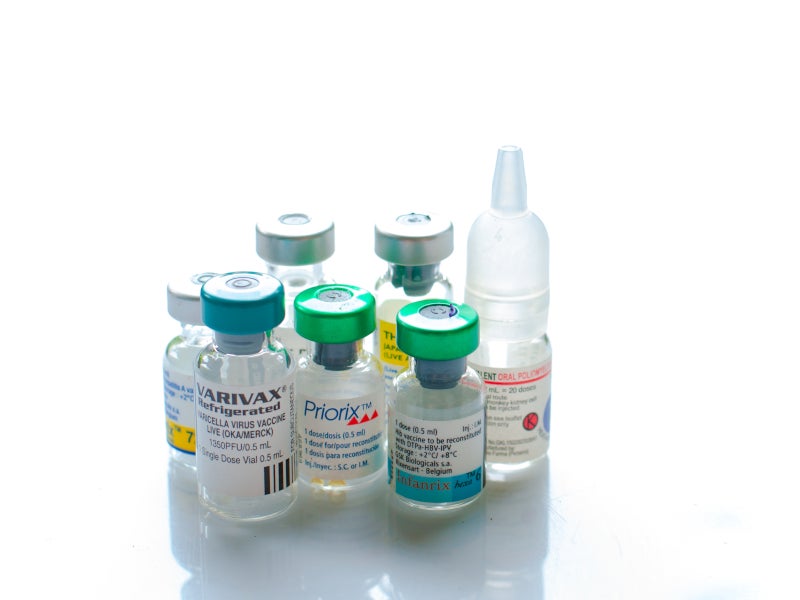PRIORIX™ is a live attenuated vaccine indicated for the prevention of measles, mumps and rubella (MMR) in individuals aged 12 months and above.
The vaccine contains a lyophilised mixture of the attenuated Schwarz measles, RIT 4385 mumps and Wistar RA 27/3 rubella virus strains, which were each acquired individually by propagation either in chick embryo tissue cultures or MRC-5 human diploid cells.
Developed by GlaxoSmithKline (GSK), PRIORIX is available as a sterile, white to slightly pink powder of lyophilised antigen component. The antigen component is reconstituted using sterile water diluent before it is administered into a 0.5ml dose.
PRIORIX is recommended to be administered in two doses, with the first dose administered at 12-15 months of age and the second dose at four to five years of age.
Regulatory approvals of PRIORIX
PRIORIX was first approved for use in the European Union by the European Medical Association (EMA) in March 2012. The vaccine has since been approved in more than 100 countries, including Canada, Australia and New Zealand.
In June 2022, PRIORIX was approved by the US Food and Drug Administration (FDA) for immunisation against MMR.
Mumps, measles and rubella (MMR) causes and symptoms
Measles, mumps and rubella are highly contagious diseases that can lead to increased mortality.
Mumps is a contagious disease that is caused by the mumps virus (MuV) and transmitted by contact with respiratory secretions, either directly or indirectly. Common symptoms of the disease include fever, headache, muscle aches, swelling of salivary glands that causes puffy cheeks, and a tender, swollen jaw. Mumps can lead to severe complications such as orchitis, meningitis, encephalitis and pancreatitis.
Measles is a contagious Morbillivirus respiratory disease that is transferred by direct touch, airborne transmission, or the inhalation of contaminated respiratory secretions. It is characterised by a blotchy rash, fever, cough, conjunctivitis or malaise and, in some cases, may also cause tiny white spots with bluish-white centres inside the mouth.
Rubella, also known as German measles, is a viral infection that is transmitted through direct touch or the inhalation of contaminated respiratory secretions. Symptoms of the disease include low-grade fever, sore throat, and a rash that begins on the face and progresses to the rest of the body.
More than 124,000 cases of measles, 225,000 cases of mumps and 10,700 cases of rubella were reported in 2021, according to data from the World Health Organisation (WHO). Several countries have reported measles outbreaks in 2022, reversing gains made towards eliminating the disease.
Measles cases increased by 79% in the first two months of 2022 alone, compared with 2021. Some of the outbreaks were mainly due to immunisation delays caused by the Covid-19 pandemic. In 2020, an estimated 23 million children missed their childhood vaccines, the highest number since 2009.
PRIORIX’s mechanism of action
PRIORIX produces neutralising antibodies that have been linked to providing protection against measles, mumps and rubella upon administration.
The vaccine produces humoral immune responses against the MMR viruses, which are measured by enzyme-linked immunosorbent assays (ELISAs) that have detected the presence of Immunoglobulin G (IgG) antibodies in clinical trials.
Clinical studies on PRIORIX
The FDA’s approval of PRIORIX was based on data from six clinical studies comparing the vaccine’s safety and efficacy with those of the M-M-R II vaccine.
The clinical trials enrolled a total of 12,151 individuals, including 6,391 in the US, who received at least one dose of the drug. The participants included 8,780 children aged between 12 and 15 months, 2,917 children aged between four and six years, and 454 adults and children aged seven years and older.
The studies compared the antibody response of PRIORIX with that of M-M-R II vaccines with respect to seroresponse rates (SRR) and geometric mean concentrations (GMC). The standard seroresponse (SSR) thresholds were 200mIU/ml, 10ELU/ml, and 10IU/ml for anti-measles virus, anti-mumps virus, and anti-rubella virus antibodies, respectively.
The first and second studies involved the 12-15 month age groups. The participants were administered the first dose of either PRIORIX or M-M-R II together with HAVRIX and VARIVAX, while children in the US also received PREVNAR 13. The studies showed that similar immune responses were generated for the first and second doses in the group receiving PRIORIX and the group receiving M-M-R II in terms of antibody SRR and GMC for all antigens.
In the third study, participants aged between four and six years received either PRIORIX or M-M-R II as a second dose following administration of an initial dose (a vaccine containing a combined MMR virus). Antibody responses were measured using sera obtained 42 days following vaccine administration.
PRIORIX showed non-inferiority to M-M-R II in terms of SRR and GMC when administered together with KINRIX and VARIVAX.
The fourth study involved children aged seven years and older who received a second dose of either PRIORIX or M-M-R II. PRIORIX demonstrated a non-inferior immune response compared with M-M-R II on the basis of SRR and antibody GMC.
The most common side effects reported by individuals of different age groups included pain, redness and swelling, apart from irritability, loss of appetite, drowsiness, and fever in the 12-15 month and four-six year age groups.










